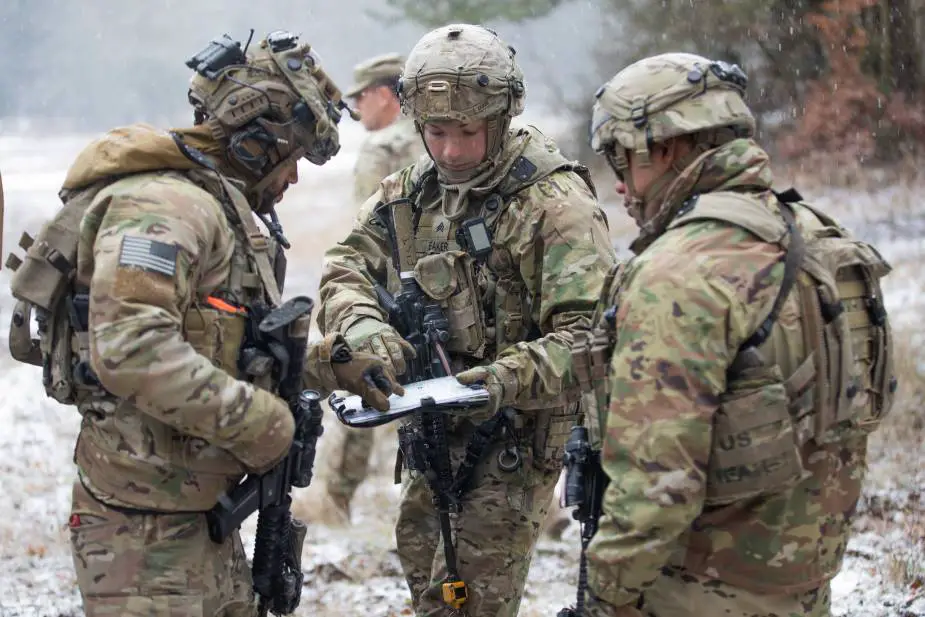Breaking news
US Army and Air Force fire support specialists form a COLT at Combined Resolve XVI.
Hohenfels, Germany — A two-person team of Airmen is dropped off by a Bradley Fighting Vehicle at the forward line of troops. They move down the line of cavalry scouts until they meet another small team, this one made up of U.S. Army artillerymen, who are dismounted from their own Bradley and are outfitting their rucksacks for an extended patrol. They are preparing to scout enemy positions, checking their radios and packing binoculars for a long patrol behind enemy lines. Staff Sgt. George Davis reports on U.S. Army’s website.
Follow Army Recognition on Google News at this link

U.S. Army Pfc. Kyle Lavorante (left) and Spc. Jakeb Tadlock, Joint Fire Support Specialists with Bravo Company, 1st Battalion, 16th Infantry Regiment, 1st Armored Brigade Combat Team, 1st Infantry Division, observe and report via radio as part of a COLT (Combat Observation Lasing Team) for Combined Resolve XVI at the Joint Military Readiness Center (JMRC) in Hohenfels, Germany, Dec. 8, 2021. (Picture source: U.S. Army/Staff Sgt. George Davis)
The teams are part of the force-on-force exercise portion of Combined Resolve XVI, which includes approximately 4,600 armed forces service members from Bulgaria, Georgia, Greece, Italy, Lithuania, Poland, Serbia, Slovakia, Slovenia, Ukraine, United Kingdom and the United States. The operations are being conducted by integrated battalions with multinational units operating under a unified command and control element, allowing the U.S., its allies and partners to experience invaluable training alongside each other.
“Today we are going out as a COLT (Combat Observation Lasing Team),” said Senior Airmen Fernando Marquez, a Joint Terminal Attack Controller with 4th Air Support Operations Group. “A COLT team is basically the eyes on the ground when our sensor assets, which typically allows us to see far, cannot do the job. We have to push behind enemy lines, or in as far as possible with the enemy, so we can provide real targeting data for the brigade and division fires assets.”
The goal of COLT teams is to identify enemy targets, and, if possible, the teams will use laser targeting systems to mark targets for precision guided munitions. Joint teams of Fire Support Teams, known as FiSTers, and JTACs are best suited for providing COLT support to an Army brigade deployed in a combat scenario.
“Our mission is a list of high-value enemy targets,” said Sgt. Devon Eaker, a Joint Fire Support Specialist with 1st Battalion, 5th Field Artillery Regiment “Hamilton’s Own,” 1st Armored Brigade Combat Team, 1st Infantry Division. “I think I’m lucky to have the six guys total that we have right here. I’ve worked with these two JTACs before, and I’ve worked with the other three FiSTers a lot, and I can’t think of a better group of dudes to send forward to do this.”
FiSTers are the 1-5FA Headquarters and Headquarters Battery fire support officers, non-commissioned officers and enlisted joint fire support specialists responsible for identifying indirect fire, or fires, missions on the Combined Resolve XVI notional battlefield. FiST teams are attached to all of the multinational maneuver units operating during CBR XVI. This is an opportunity for these multinational units to experience the capability of the U.S. to provide close air support in joint operations.
“My fire support NCOs are organic to the field artillery battalion but are tasked out to each maneuver element,” said 1st Sgt. Michael York of HHB. “They are combat multipliers, and they enable the maneuver units to perform their mission by providing them with fires. So, if there is ever artillery, mortars or attack aviation getting called in, there is a fire supporter attached to that asset.”
Air Force JTACs direct the actions of aircraft while engaged in close air support. They can call in close air support from F-22s, A-10s, F-35s, or anything that the U.S. Air Force can provide air-to-ground operations.
“We’re fighting this new fight,” Marquez said. “We’re getting out of the COIN [counterinsurgency] mentality and moving into this new LSCO [large scale combat operations] fight. So, we are trying to shape the way we fight this new battle.”
Despite the proliferation of unmanned aerial vehicles in combat operations, both the Army and the Air Force continue to train and develop ground-force fire support teams. The force-on-force exercise held during Combined Resolve XVI at the Joint Multinational Training Center in Germany provides an excellent training opportunity for COLT.
“We’re essentially deep strike and reconnaissance,” Eaker said. “We get out there, forward of the FLOT, as close to the enemy as we can, see what’s coming and pitch it backwards. And if we can, we’ll kill what’s out there. We have access to aircraft via JTACs, fixed and rotary wing. We are in range of all artillery that the brigade has now through 1-5FA. With those combined, there’s not much out there that we can’t kill.”
The modern battlefield is shaped by UAVs directing cameras toward the enemy to gather intelligence. As the fight turns from terrorism to an enemy with more sophisticated electronic equipment and air defense, the potential disruption of UAV imaging is a very real threat. Well trained COLT teams ensure that U.S. Forces maintain the ability to penetrate enemy formations, identify threats and deliver fires munitions onto those threats, helping to maintain overwhelming firepower which is critical to victory on the LSCO battlefield.

U.S. Army Sgt. Devon Eaker (center), a joint fire support specialist with 1st Battalion, 5th Field Artillery Regiment, 1st Armored Brigade Combat Team, 1st Infantry Division, coordinates with members of the COLT (Combat Observation Lasing Team), as they prepare for missions during Combined Resolve XVI at the Joint Military Readiness Center (JMRC) in Hohenfels, Germany, Dec. 8, 2021. (Picture source: U.S. Army/Staff Sgt. George Davis)



















